brake light FORD F250 SUPER DUTY 1999 User Guide
[x] Cancel search | Manufacturer: FORD, Model Year: 1999, Model line: F250 SUPER DUTY, Model: FORD F250 SUPER DUTY 1999Pages: 248, PDF Size: 1.53 MB
Page 134 of 248
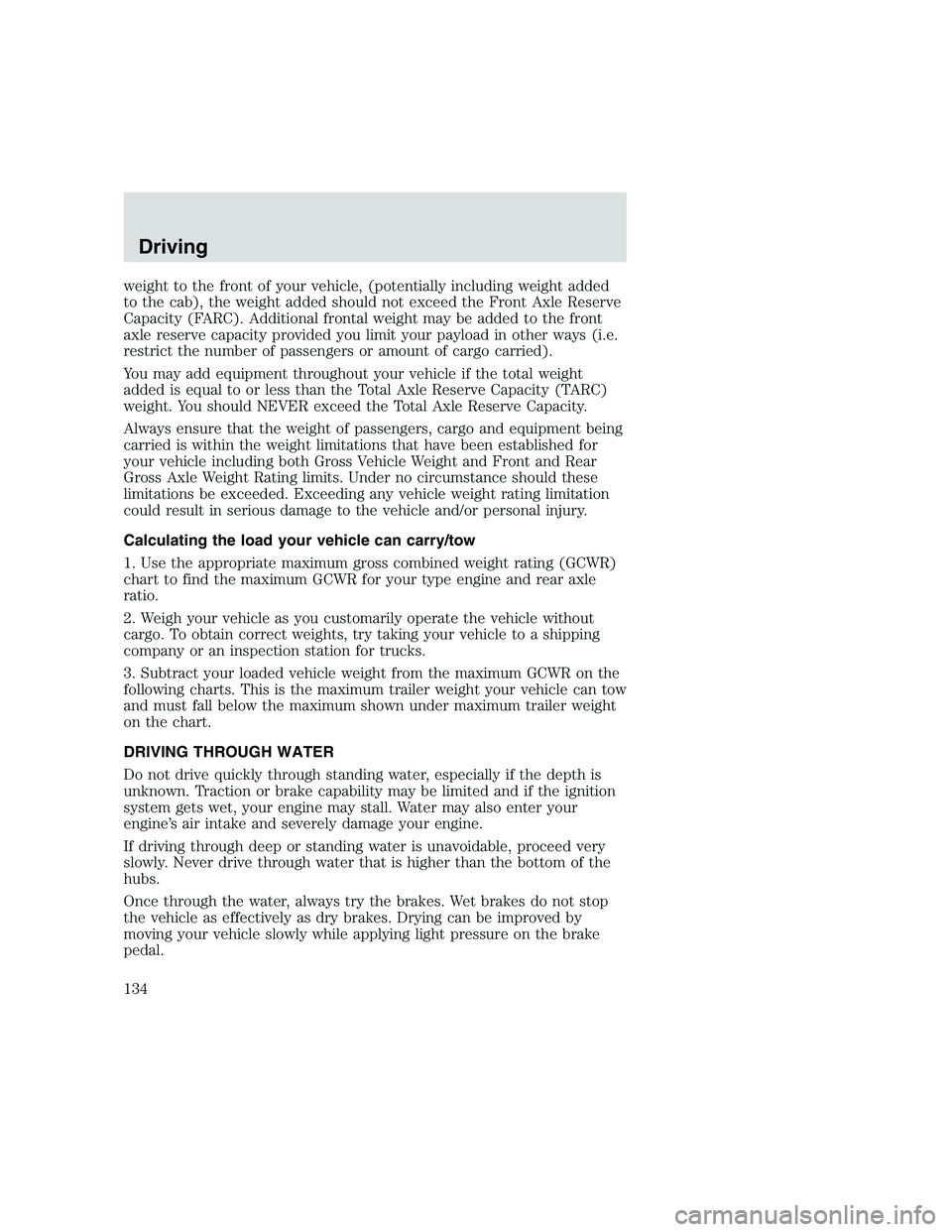
weight to the front of your vehicle, (potentially including weight added
to the cab), the weight added should not exceed the Front Axle Reserve
Capacity (FARC). Additional frontal weight may be added to the front
axle reserve capacity provided you limit your payload in other ways (i.e.
restrict the number of passengers or amount of cargo carried).
You may add equipment throughout your vehicle if the total weight
added is equal to or less than the Total Axle Reserve Capacity (TARC)
weight. You should NEVER exceed the Total Axle Reserve Capacity.
Always ensure that the weight of passengers, cargo and equipment being
carried is within the weight limitations that have been established for
your vehicle including both Gross Vehicle Weight and Front and Rear
Gross Axle Weight Rating limits. Under no circumstance should these
limitations be exceeded. Exceeding any vehicle weight rating limitation
could result in serious damage to the vehicle and/or personal injury.
Calculating the load your vehicle can carry/tow
1. Use the appropriate maximum gross combined weight rating (GCWR)
chart to find the maximum GCWR for your type engine and rear axle
ratio.
2. Weigh your vehicle as you customarily operate the vehicle without
cargo. To obtain correct weights, try taking your vehicle to a shipping
company or an inspection station for trucks.
3. Subtract your loaded vehicle weight from the maximum GCWR on the
following charts. This is the maximum trailer weight your vehicle can tow
and must fall below the maximum shown under maximum trailer weight
on the chart.
DRIVING THROUGH WATER
Do not drive quickly through standing water, especially if the depth is
unknown. Traction or brake capability may be limited and if the ignition
system gets wet, your engine may stall. Water may also enter your
engine’s air intake and severely damage your engine.
If driving through deep or standing water is unavoidable, proceed very
slowly. Never drive through water that is higher than the bottom of the
hubs.
Once through the water, always try the brakes. Wet brakes do not stop
the vehicle as effectively as dry brakes. Drying can be improved by
moving your vehicle slowly while applying light pressure on the brake
pedal.
Driving
134
Page 176 of 248
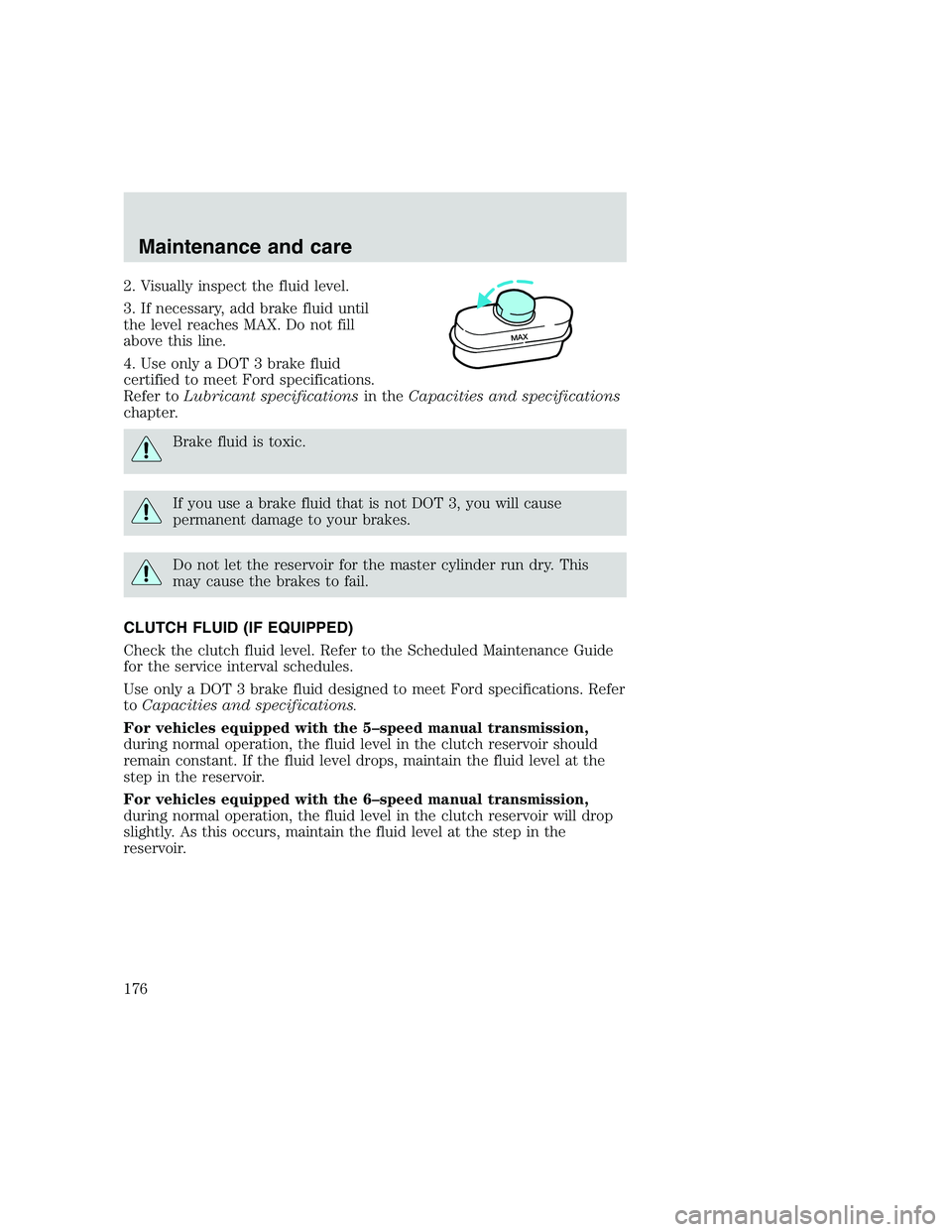
2. Visually inspect the fluid level.
3. If necessary, add brake fluid until
the level reaches MAX. Do not fill
above this line.
4. Use only a DOT 3 brake fluid
certified to meet Ford specifications.
Refer toLubricant specificationsin theCapacities and specifications
chapter.
Brake fluid is toxic.
If you use a brake fluid that is not DOT 3, you will cause
permanent damage to your brakes.
Do not let the reservoir for the master cylinder run dry. This
may cause the brakes to fail.
CLUTCH FLUID (IF EQUIPPED)
Check the clutch fluid level. Refer to the Scheduled Maintenance Guide
for the service interval schedules.
Use only a DOT 3 brake fluid designed to meet Ford specifications. Refer
toCapacities and specifications.
For vehicles equipped with the 5–speed manual transmission,
during normal operation, the fluid level in the clutch reservoir should
remain constant. If the fluid level drops, maintain the fluid level at the
step in the reservoir.
For vehicles equipped with the 6–speed manual transmission,
during normal operation, the fluid level in the clutch reservoir will drop
slightly. As this occurs, maintain the fluid level at the step in the
reservoir.
M
A
X
Maintenance and care
176
Page 201 of 248
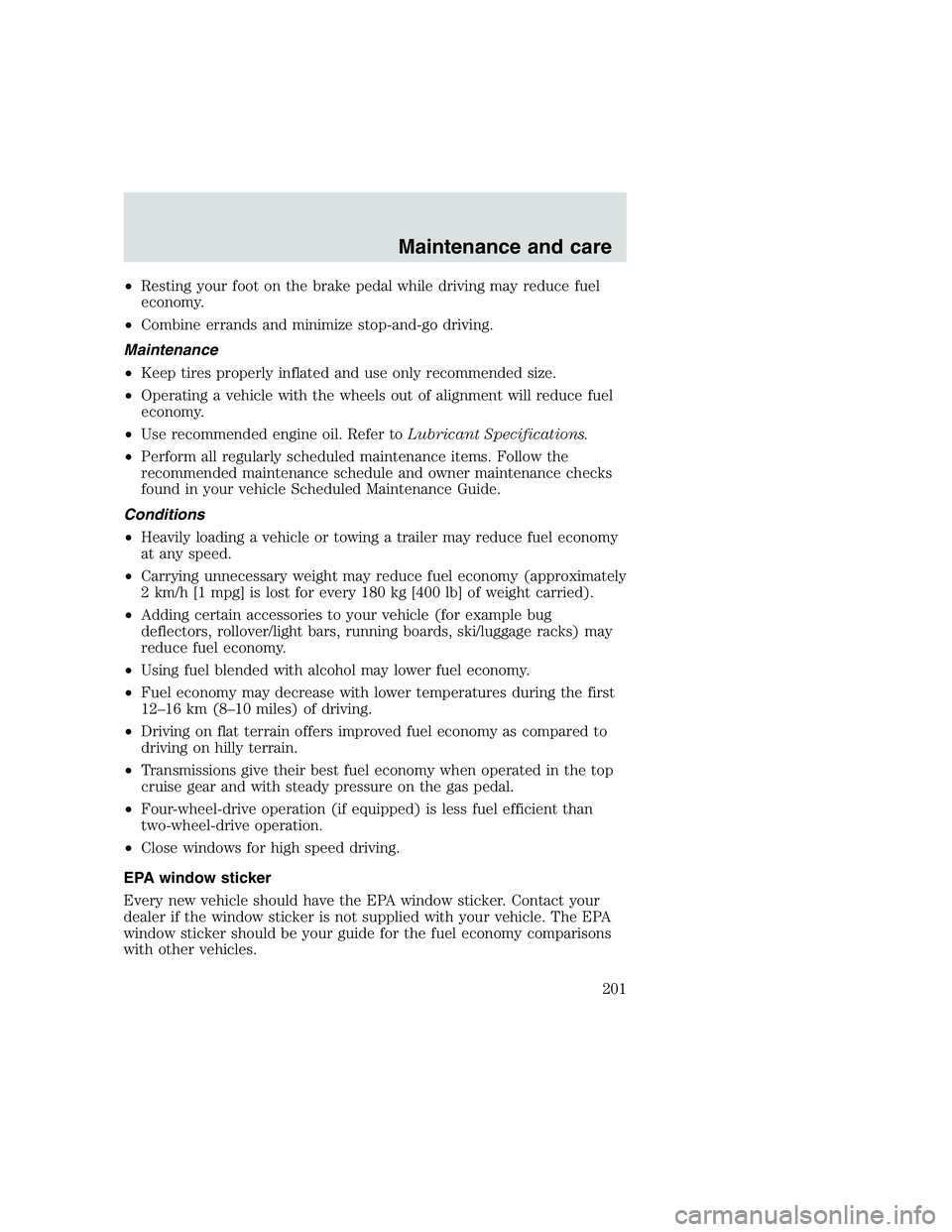
•Resting your foot on the brake pedal while driving may reduce fuel
economy.
•Combine errands and minimize stop-and-go driving.
Maintenance
•Keep tires properly inflated and use only recommended size.
•Operating a vehicle with the wheels out of alignment will reduce fuel
economy.
•Use recommended engine oil. Refer toLubricant Specifications.
•Perform all regularly scheduled maintenance items. Follow the
recommended maintenance schedule and owner maintenance checks
found in your vehicle Scheduled Maintenance Guide.
Conditions
•Heavily loading a vehicle or towing a trailer may reduce fuel economy
at any speed.
•Carrying unnecessary weight may reduce fuel economy (approximately
2 km/h [1 mpg] is lost for every 180 kg [400 lb] of weight carried).
•Adding certain accessories to your vehicle (for example bug
deflectors, rollover/light bars, running boards, ski/luggage racks) may
reduce fuel economy.
•Using fuel blended with alcohol may lower fuel economy.
•Fuel economy may decrease with lower temperatures during the first
12–16 km (8–10 miles) of driving.
•Driving on flat terrain offers improved fuel economy as compared to
driving on hilly terrain.
•Transmissions give their best fuel economy when operated in the top
cruise gear and with steady pressure on the gas pedal.
•Four-wheel-drive operation (if equipped) is less fuel efficient than
two-wheel-drive operation.
•Close windows for high speed driving.
EPA window sticker
Every new vehicle should have the EPA window sticker. Contact your
dealer if the window sticker is not supplied with your vehicle. The EPA
window sticker should be your guide for the fuel economy comparisons
with other vehicles.
Maintenance and care
201
Page 203 of 248
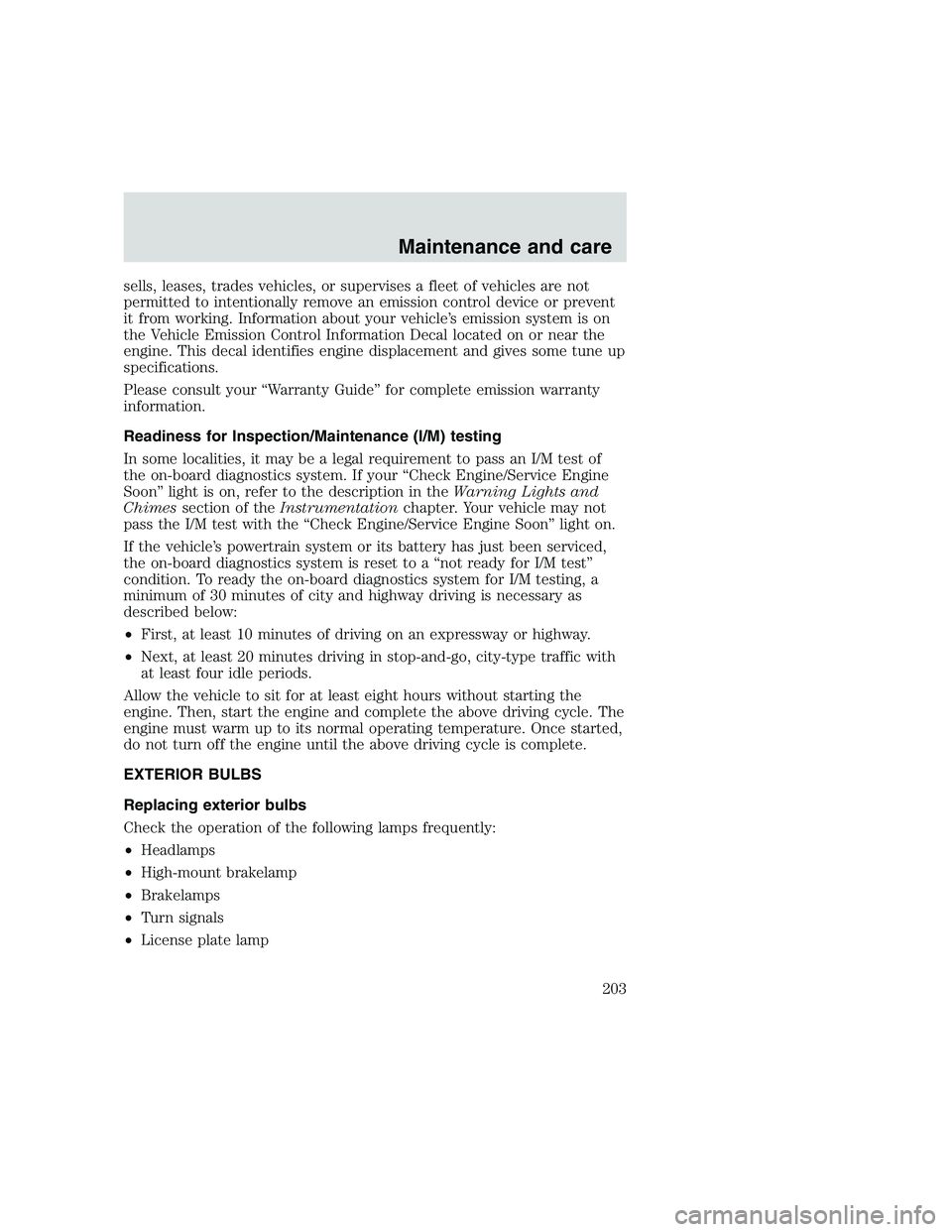
sells, leases, trades vehicles, or supervises a fleet of vehicles are not
permitted to intentionally remove an emission control device or prevent
it from working. Information about your vehicle’s emission system is on
the Vehicle Emission Control Information Decal located on or near the
engine. This decal identifies engine displacement and gives some tune up
specifications.
Please consult your “Warranty Guide” for complete emission warranty
information.
Readiness for Inspection/Maintenance (I/M) testing
In some localities, it may be a legal requirement to pass an I/M test of
the on-board diagnostics system. If your “Check Engine/Service Engine
Soon” light is on, refer to the description in theWarning Lights and
Chimessection of theInstrumentationchapter. Your vehicle may not
pass the I/M test with the “Check Engine/Service Engine Soon” light on.
If the vehicle’s powertrain system or its battery has just been serviced,
the on-board diagnostics system is reset to a “not ready for I/M test”
condition. To ready the on-board diagnostics system for I/M testing, a
minimum of 30 minutes of city and highway driving is necessary as
described below:
•First, at least 10 minutes of driving on an expressway or highway.
•Next, at least 20 minutes driving in stop-and-go, city-type traffic with
at least four idle periods.
Allow the vehicle to sit for at least eight hours without starting the
engine. Then, start the engine and complete the above driving cycle. The
engine must warm up to its normal operating temperature. Once started,
do not turn off the engine until the above driving cycle is complete.
EXTERIOR BULBS
Replacing exterior bulbs
Check the operation of the following lamps frequently:
•Headlamps
•High-mount brakelamp
•Brakelamps
•Turn signals
•License plate lamp
Maintenance and care
203
Page 207 of 248
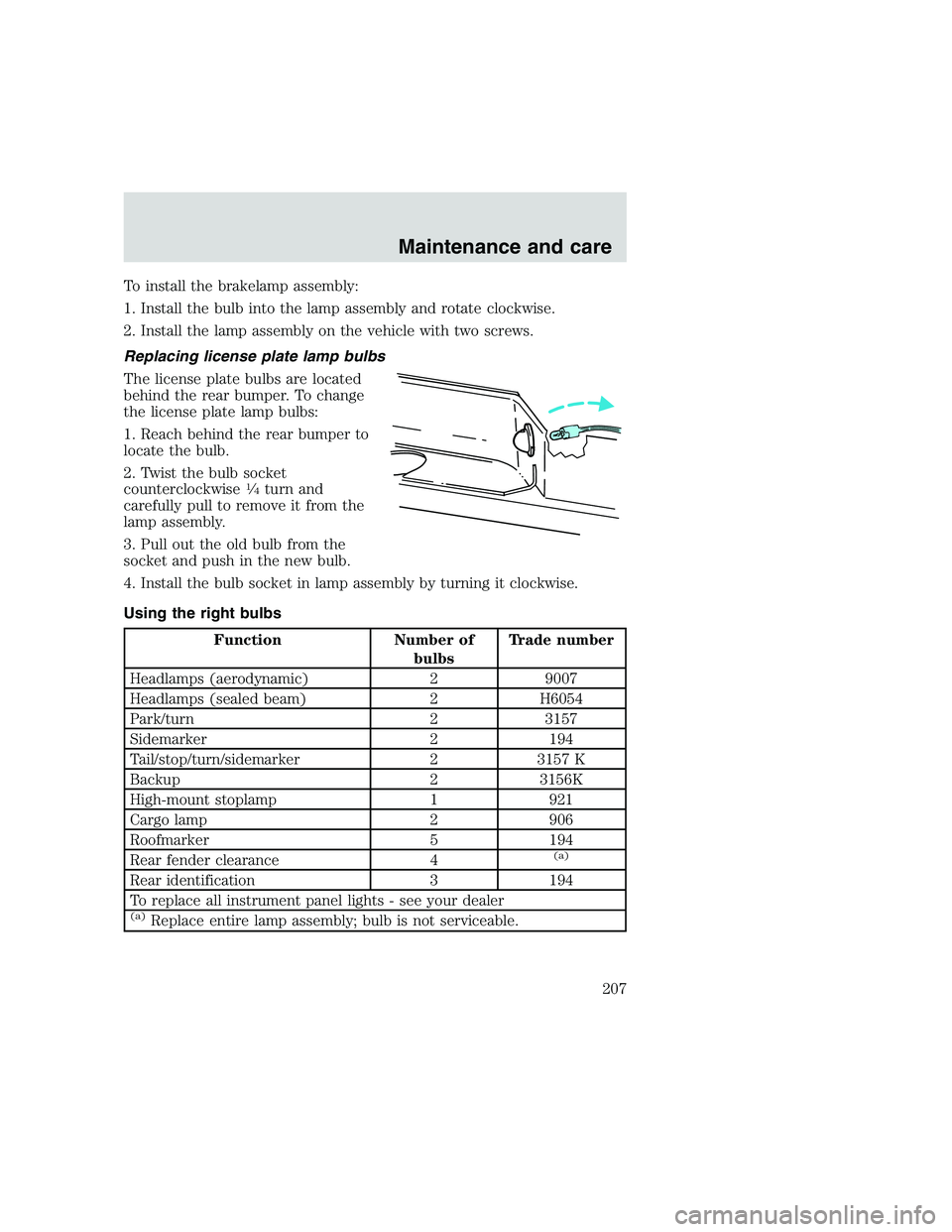
To install the brakelamp assembly:
1. Install the bulb into the lamp assembly and rotate clockwise.
2. Install the lamp assembly on the vehicle with two screws.
Replacing license plate lamp bulbs
The license plate bulbs are located
behind the rear bumper. To change
the license plate lamp bulbs:
1. Reach behind the rear bumper to
locate the bulb.
2. Twist the bulb socket
counterclockwise
1�4turn and
carefully pull to remove it from the
lamp assembly.
3. Pull out the old bulb from the
socket and push in the new bulb.
4. Install the bulb socket in lamp assembly by turning it clockwise.
Using the right bulbs
Function Number of
bulbsTrade number
Headlamps (aerodynamic) 2 9007
Headlamps (sealed beam) 2 H6054
Park/turn 2 3157
Sidemarker 2 194
Tail/stop/turn/sidemarker 2 3157 K
Backup 2 3156K
High-mount stoplamp 1 921
Cargo lamp 2 906
Roofmarker 5 194
Rear fender clearance 4
(a)
Rear identification 3 194
To replace all instrument panel lights - see your dealer
(a)Replace entire lamp assembly; bulb is not serviceable.
Maintenance and care
207
Page 208 of 248
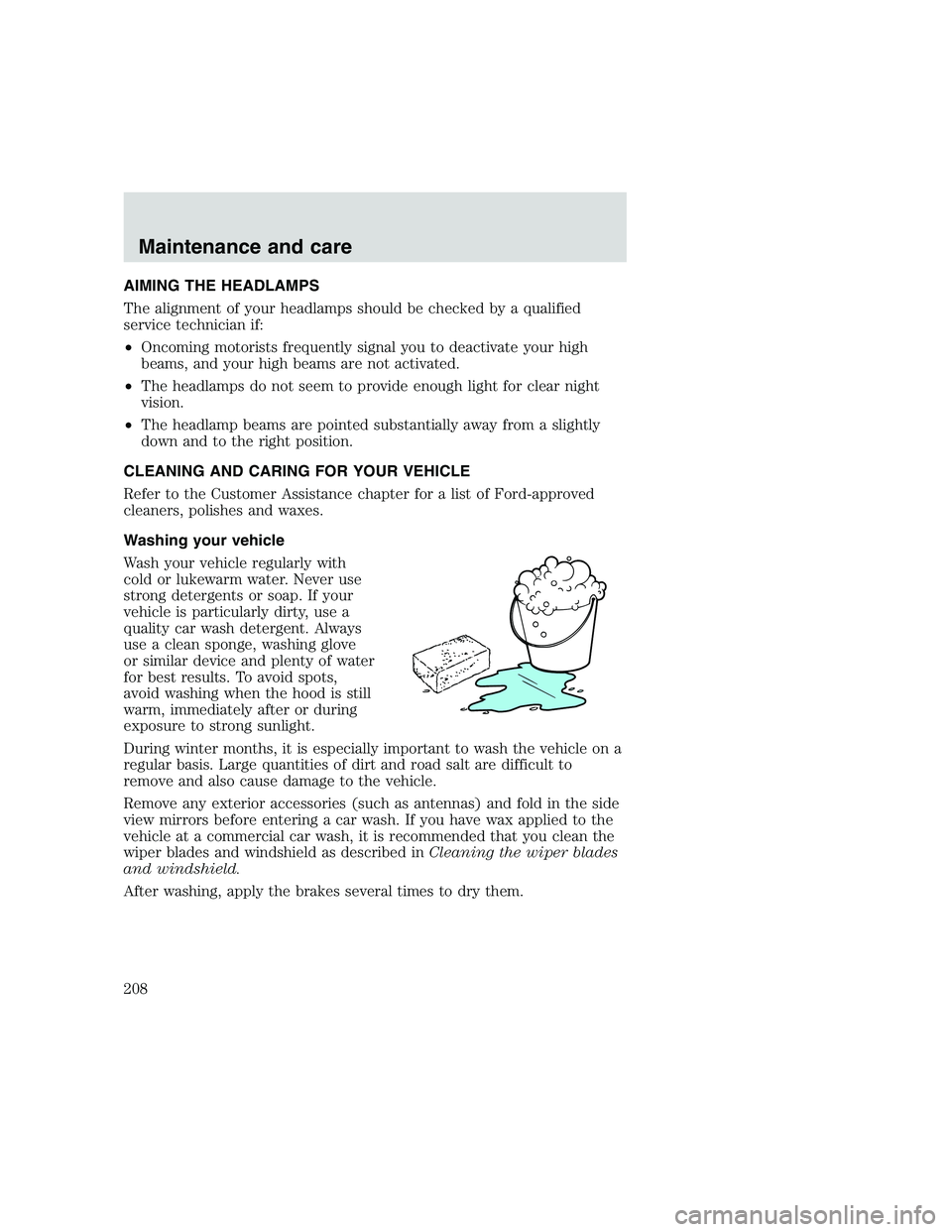
AIMING THE HEADLAMPS
The alignment of your headlamps should be checked by a qualified
service technician if:
•Oncoming motorists frequently signal you to deactivate your high
beams, and your high beams are not activated.
•The headlamps do not seem to provide enough light for clear night
vision.
•The headlamp beams are pointed substantially away from a slightly
down and to the right position.
CLEANING AND CARING FOR YOUR VEHICLE
Refer to the Customer Assistance chapter for a list of Ford-approved
cleaners, polishes and waxes.
Washing your vehicle
Wash your vehicle regularly with
cold or lukewarm water. Never use
strong detergents or soap. If your
vehicle is particularly dirty, use a
quality car wash detergent. Always
use a clean sponge, washing glove
or similar device and plenty of water
for best results. To avoid spots,
avoid washing when the hood is still
warm, immediately after or during
exposure to strong sunlight.
During winter months, it is especially important to wash the vehicle on a
regular basis. Large quantities of dirt and road salt are difficult to
remove and also cause damage to the vehicle.
Remove any exterior accessories (such as antennas) and fold in the side
view mirrors before entering a car wash. If you have wax applied to the
vehicle at a commercial car wash, it is recommended that you clean the
wiper blades and windshield as described inCleaning the wiper blades
and windshield.
After washing, apply the brakes several times to dry them.
Maintenance and care
208
Page 236 of 248
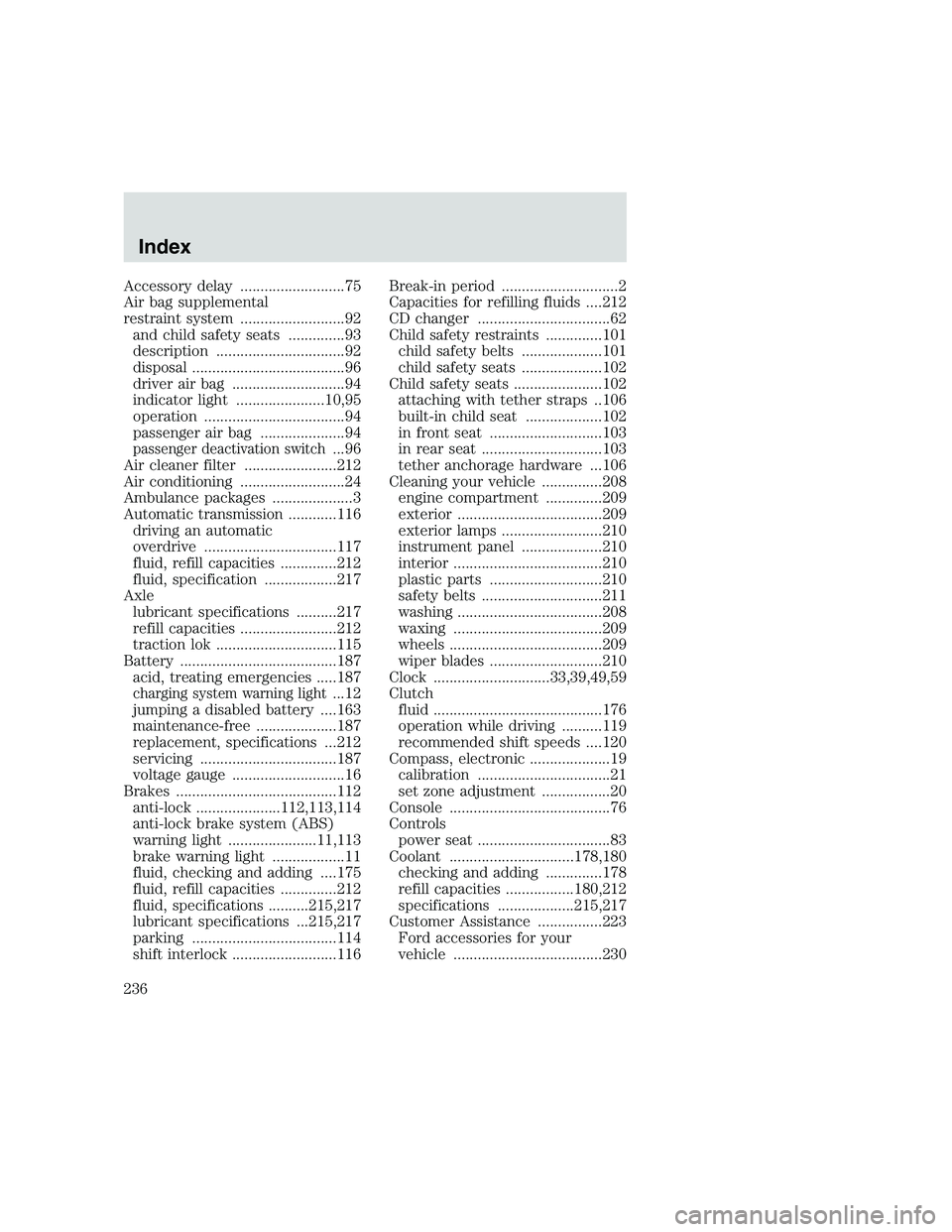
Accessory delay ..........................75
Air bag supplemental
restraint system ..........................92
and child safety seats ..............93
description ................................92
disposal ......................................96
driver air bag ............................94
indicator light ......................10,95
operation ...................................94
passenger air bag .....................94
passenger deactivation switch...96
Air cleaner filter .......................212
Air conditioning ..........................24
Ambulance packages ....................3
Automatic transmission ............116
driving an automatic
overdrive .................................117
fluid, refill capacities ..............212
fluid, specification ..................217
Axle
lubricant specifications ..........217
refill capacities ........................212
traction lok ..............................115
Battery .......................................187
acid, treating emergencies .....187
charging system warning light...12
jumping a disabled battery ....163
maintenance-free ....................187
replacement, specifications ...212
servicing ..................................187
voltage gauge ............................16
Brakes ........................................112
anti-lock .....................112,113,114
anti-lock brake system (ABS)
warning light ......................11,113
brake warning light ..................11
fluid, checking and adding ....175
fluid, refill capacities ..............212
fluid, specifications ..........215,217
lubricant specifications ...215,217
parking ....................................114
shift interlock ..........................116Break-in period .............................2
Capacities for refilling fluids ....212
CD changer .................................62
Child safety restraints ..............101
child safety belts ....................101
child safety seats ....................102
Child safety seats ......................102
attaching with tether straps ..106
built-in child seat ...................102
in front seat ............................103
in rear seat ..............................103
tether anchorage hardware ...106
Cleaning your vehicle ...............208
engine compartment ..............209
exterior ....................................209
exterior lamps .........................210
instrument panel ....................210
interior .....................................210
plastic parts ............................210
safety belts ..............................211
washing ....................................208
waxing .....................................209
wheels ......................................209
wiper blades ............................210
Clock .............................33,39,49,59
Clutch
fluid ..........................................176
operation while driving ..........119
recommended shift speeds ....120
Compass, electronic ....................19
calibration .................................21
set zone adjustment .................20
Console ........................................76
Controls
power seat .................................83
Coolant ...............................178,180
checking and adding ..............178
refill capacities .................180,212
specifications ...................215,217
Customer Assistance ................223
Ford accessories for your
vehicle .....................................230
Index
236
Page 238 of 248
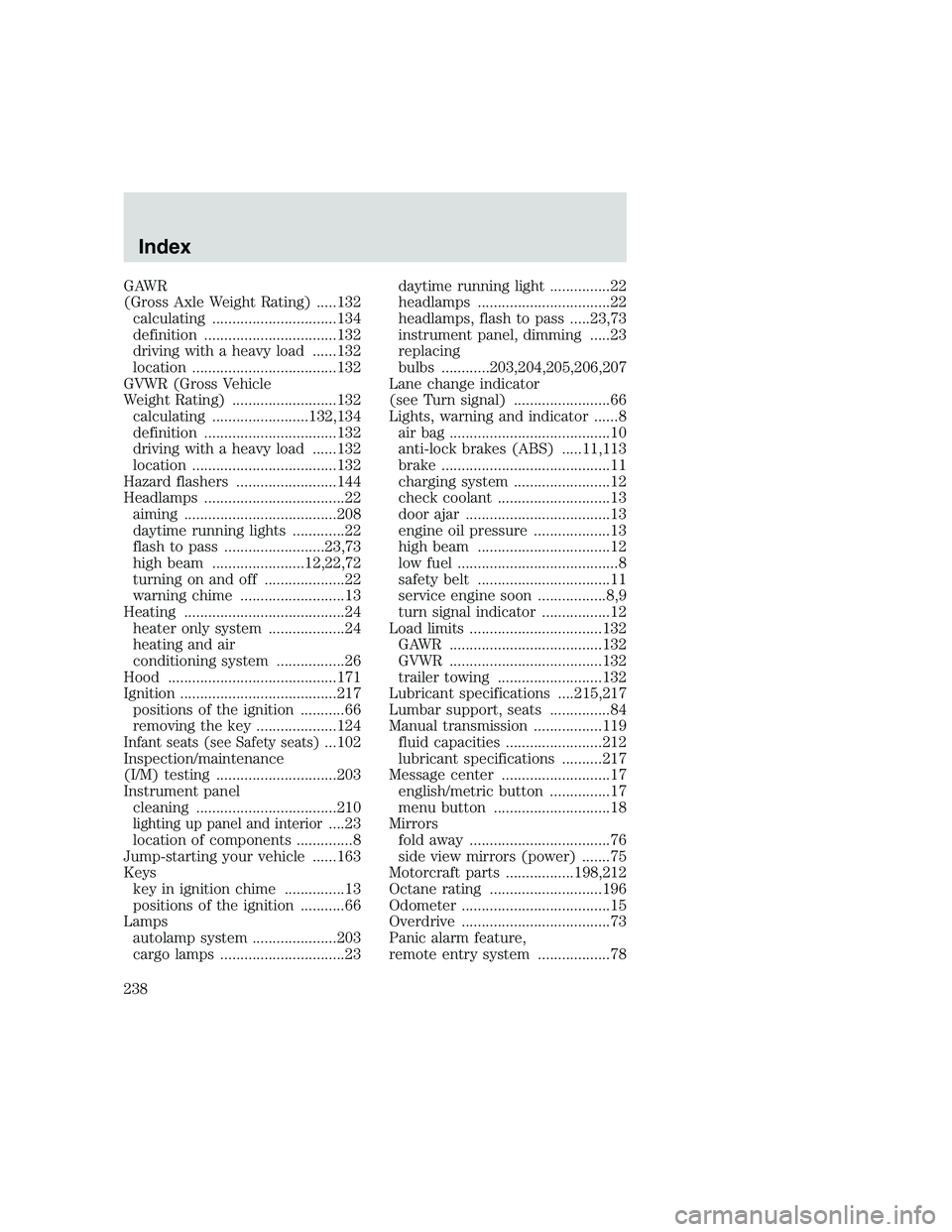
GAWR
(Gross Axle Weight Rating) .....132
calculating ...............................134
definition .................................132
driving with a heavy load ......132
location ....................................132
GVWR (Gross Vehicle
Weight Rating) ..........................132
calculating ........................132,134
definition .................................132
driving with a heavy load ......132
location ....................................132
Hazard flashers .........................144
Headlamps ...................................22
aiming ......................................208
daytime running lights .............22
flash to pass .........................23,73
high beam .......................12,22,72
turning on and off ....................22
warning chime ..........................13
Heating ........................................24
heater only system ...................24
heating and air
conditioning system .................26
Hood ..........................................171
Ignition .......................................217
positions of the ignition ...........66
removing the key ....................124
Infant seats (see Safety seats)...102
Inspection/maintenance
(I/M) testing ..............................203
Instrument panel
cleaning ...................................210
lighting up panel and interior....23
location of components ..............8
Jump-starting your vehicle ......163
Keys
key in ignition chime ...............13
positions of the ignition ...........66
Lamps
autolamp system .....................203
cargo lamps ...............................23daytime running light ...............22
headlamps .................................22
headlamps, flash to pass .....23,73
instrument panel, dimming .....23
replacing
bulbs ............203,204,205,206,207
Lane change indicator
(see Turn signal) ........................66
Lights, warning and indicator ......8
air bag ........................................10
anti-lock brakes (ABS) .....11,113
brake ..........................................11
charging system ........................12
check coolant ............................13
door ajar ....................................13
engine oil pressure ...................13
high beam .................................12
low fuel ........................................8
safety belt .................................11
service engine soon .................8,9
turn signal indicator .................12
Load limits .................................132
GAWR ......................................132
GVWR ......................................132
trailer towing ..........................132
Lubricant specifications ....215,217
Lumbar support, seats ...............84
Manual transmission .................119
fluid capacities ........................212
lubricant specifications ..........217
Message center ...........................17
english/metric button ...............17
menu button .............................18
Mirrors
fold away ...................................76
side view mirrors (power) .......75
Motorcraft parts .................198,212
Octane rating ............................196
Odometer .....................................15
Overdrive .....................................73
Panic alarm feature,
remote entry system ..................78
Index
238
Page 239 of 248
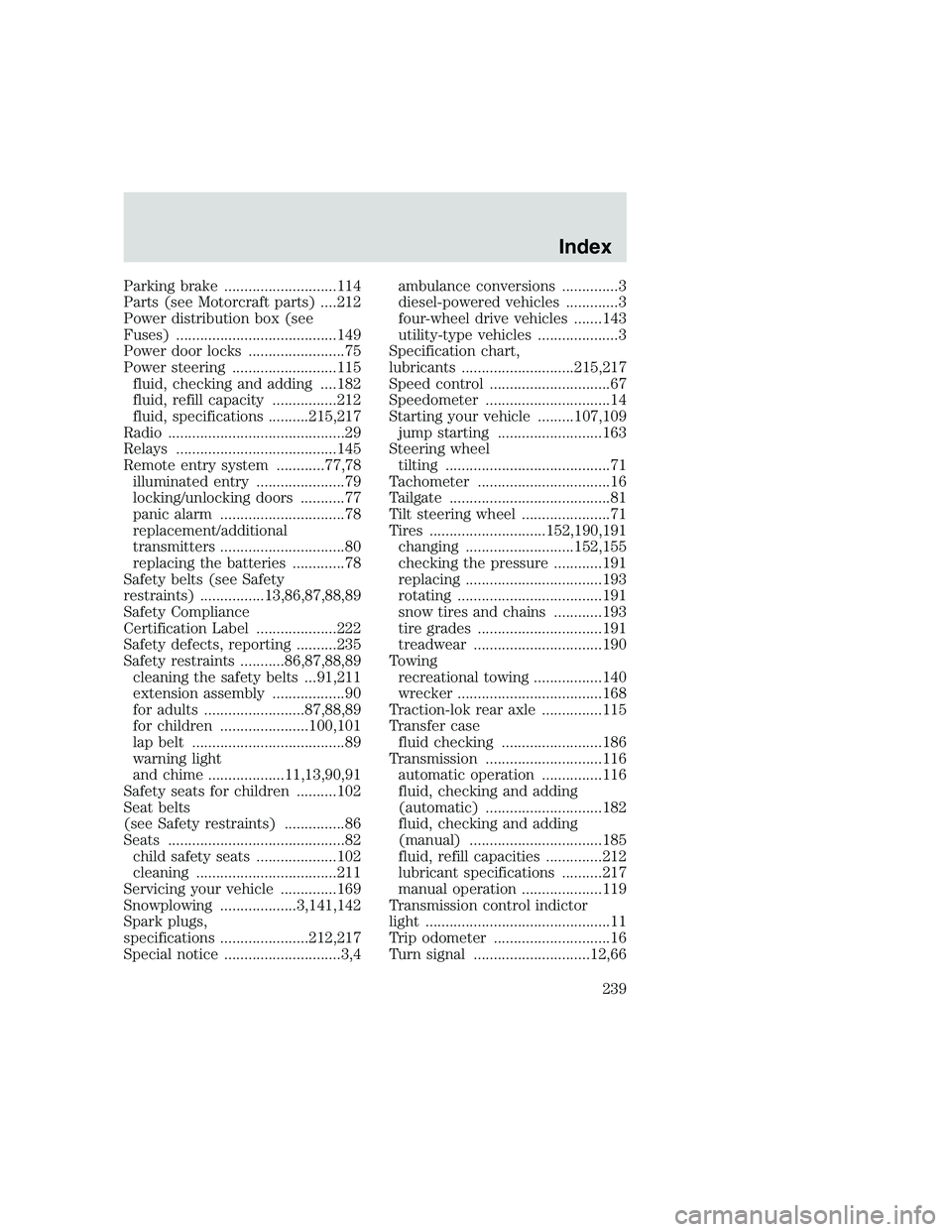
Parking brake ............................114
Parts (see Motorcraft parts) ....212
Power distribution box (see
Fuses) ........................................149
Power door locks ........................75
Power steering ..........................115
fluid, checking and adding ....182
fluid, refill capacity ................212
fluid, specifications ..........215,217
Radio ............................................29
Relays ........................................145
Remote entry system ............77,78
illuminated entry ......................79
locking/unlocking doors ...........77
panic alarm ...............................78
replacement/additional
transmitters ...............................80
replacing the batteries .............78
Safety belts (see Safety
restraints) ................13,86,87,88,89
Safety Compliance
Certification Label ....................222
Safety defects, reporting ..........235
Safety restraints ...........86,87,88,89
cleaning the safety belts ...91,211
extension assembly ..................90
for adults .........................87,88,89
for children ......................100,101
lap belt ......................................89
warning light
and chime ...................11,13,90,91
Safety seats for children ..........102
Seat belts
(see Safety restraints) ...............86
Seats ............................................82
child safety seats ....................102
cleaning ...................................211
Servicing your vehicle ..............169
Snowplowing ...................3,141,142
Spark plugs,
specifications ......................212,217
Special notice .............................3,4ambulance conversions ..............3
diesel-powered vehicles .............3
four-wheel drive vehicles .......143
utility-type vehicles ....................3
Specification chart,
lubricants ............................215,217
Speed control ..............................67
Speedometer ...............................14
Starting your vehicle .........107,109
jump starting ..........................163
Steering wheel
tilting .........................................71
Tachometer .................................16
Tailgate ........................................81
Tilt steering wheel ......................71
Tires .............................152,190,191
changing ...........................152,155
checking the pressure ............191
replacing ..................................193
rotating ....................................191
snow tires and chains ............193
tire grades ...............................191
treadwear ................................190
Towing
recreational towing .................140
wrecker ....................................168
Traction-lok rear axle ...............115
Transfer case
fluid checking .........................186
Transmission .............................116
automatic operation ...............116
fluid, checking and adding
(automatic) .............................182
fluid, checking and adding
(manual) .................................185
fluid, refill capacities ..............212
lubricant specifications ..........217
manual operation ....................119
Transmission control indictor
light ..............................................11
Trip odometer .............................16
Turn signal .............................12,66
Index
239